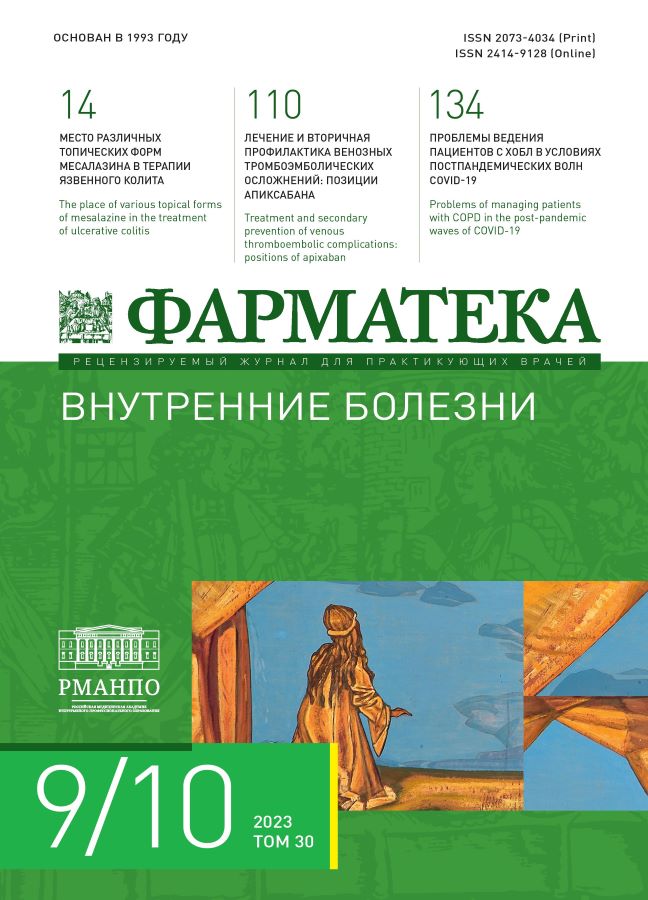A new approach to influencing the renin-angiotensin-aldosterone system: aldosterone synthase inhibitor badrostat
- Авторлар: Leonova M.V.1
-
Мекемелер:
- Interregional Public Organization “Association of Clinical Pharmacologists” (Moscow Branch)
- Шығарылым: Том 30, № 9/10 (2023)
- Беттер: 80-83
- Бөлім: Cardiology
- URL: https://journals.eco-vector.com/2073-4034/article/view/624904
- DOI: https://doi.org/10.18565/pharmateca.2023.9-10.80-83
- ID: 624904
Дәйексөз келтіру
Аннотация
The problem of treatment of resistant arterial hypertension (AH) is related to the fact that in patients who received at least three antihypertensive drugs, including a renin-angiotensin-aldosterone system (RAAS) inhibitor, a calcium channel blocker and a diuretic in the maximum tolerated doses, the target level of blood pressure (BP) is not achieved (BP≥140/90 mm Hg). Guidelines for the AH treatment recommend adding the mineralocorticoid receptor antagonist spironolactone as a fourth agent to pharmacotherapy because the mechanisms underlying resistant hypertension are associated with persistent excess fluid retention. However, the use of mineralocorticoid receptor antagonists (spironolactone, eplerenone) has a number of disadvantages associated with the possibility of reducing the effectiveness of the feedback mechanism and the development of side effects (hyperkalemia, sexual disorders), which limits their use in resistant hypertension. A new approach to influencing the RAAS is associated with the search for drugs that have a more selective effect on aldosterone - inhibition of aldosterone synthase. Recent publications present the results of studies of a new aldosterone synthase inhibitor, bacdrostat, intended for the treatment of diseases with elevated aldosterone levels. According to the results of phase 1 trials on healthy volunteers, bacdrostat showed a dose-dependent decrease in plasma aldosterone levels in the dose range of 1.5-10.0 mg. A BrigHTN phase 2 trial on evaluation of the efficacy of bacdrostat in patients with resistant hypertension, in which bacdrostat was used at doses of 0.5 mg, 1.0, 2.0 mg/day within 12 weeks, was recently completed. The study was terminated earlier than expected due to a significant difference in systolic BP reduction at the 2 mg dose compared with placebo after 12 weeks of therapy (-11.0 mmHg; P=0.003). There were no serious side effects and cases of adrenal insufficiency. Further research in area of target organ protection in hypertensive patients may pave the way for increased use of aldosterone synthase inhibitors.
Толық мәтін
Авторлар туралы
M. Leonova
Interregional Public Organization “Association of Clinical Pharmacologists” (Moscow Branch)
Хат алмасуға жауапты Автор.
Email: anti23@mail.ru
ORCID iD: 0000-0001-8228-1114
SPIN-код: 3281-7884
Dr. Sci. (Med.), Professor, Corresponding Member of the Russian Academy of Natural Sciences, Member
Ресей, MoscowӘдебиет тізімі
- Williams B., Mancia G., Spiering W., et al. ESC Scientific Document Group. 2018 ESC/ESH Guidelines for the management of arterial hypertension. Eur Heart J. 2018;39(33):3021–104. doi: 10.1093/eurheartj/ehy339.
- Whelton P.K., Carey R.M., Aronow W.S., et al. 2017 ACC/AHA/AAPA/ABC/ACPM/AGS/APhA/ASH/ASPC/NMA/PCNA Guideline for the prevention, detection, evaluation, and management of high blood pressure in adults: a report of the American College of Cardiology/American Heart Association Task Force on Clinical Practice Guidelines. Hypertension. 2018;71(6):e13–115. doi: 10.1161/HYP.0000000000000065.
- Noubiap J.J., Nansseu J.R., Nyaga U.F., et al. Global prevalence of resistant hypertension: a meta-analysis of data from 3.2 million patients. Heart. 2019;105(2):98–105. doi: 10.1136/heartjnl-2018-313599.
- Kaczmarski K.R., Sozio S.M., Chen J., et al. Resistant hypertension and cardiovascular disease mortality in the US: results from the National Health and Nutrition Examination Survey (NHANES). BMC. Nephrol. 2019;20(1):138. doi: 10.1186/s12882-019-1315-0.
- Yoon M., You S.C., Oh J., et al. Prevalence and prognosis of refractory hypertension diagnosed using ambulatory blood pressure measurements. Hypertens Res. 2022;45(8):1353–62. doi: 10.1038/s41440-021-00845-5.
- Egan B.M., Li J. Role of aldosterone blockade in resistant hypertension. Semin Nephrol. 2014;34(3):273–84. doi: 10.1016/j.semnephrol.2014.04.004.
- Carey R.M., Sakhuja S., Calhoun D.A., et al. Prevalence of apparent treatment-resistant hypertension in the United States. Hypertension. 2019;73(2):424–31. doi: 10.1161/HYPERTENSIONAHA.118.12191.
- Lainscak M., Pelliccia F., Rosano G., et al. Safety profile of mineralocorticoid receptor antagonists: Spironolactone and eplerenone. Int J Cardiol. 2015;200:25–9. doi: 10.1016/j.ijcard.2015.05.127.
- Seferovic P.M., Pelliccia F., Zivkovic I., et al. Mineralocorticoid receptor antagonists, a class beyond spironolactone--Focus on the special pharmacologic properties of eplerenone. Int J Cardiol. 2015;200:3–7. doi: 10.1016/j.ijcard.2015.02.096.
- Duggan S. Osilodrostat: first approval. Drugs. 2020;80(5):495–500. doi: 10.1007/s40265-020-01277-0.
- Perosevic M., Tritos N.A. Clinical utility of osilodrostat in Cushing’s Disease: review of currently available literature. Drug Des Devel Ther. 2023;17:1303–12. doi: 10.2147/DDDT.S315359.
- Bogman K., Schwab D., Delporte M.L., et al. Preclinical and early clinical profile of a highly selective and potent oral inhibitor of aldosterone synthase (CYP11B2). Hypertension. 2017;69(1):189–96. doi: 10.1161/HYPERTENSIONAHA.116.07716.
- Freeman M.W., Bond M., Murphy B., et al. Results from a phase 1, randomized, double-blind, multiple ascending dose study characterizing the pharmacokinetics and demonstrating the safety and selectivity of the aldosterone synthase inhibitor baxdrostat in healthy volunteers. Hypertens Res. 2023;46(1):108–18. doi: 10.1038/s41440-022-01070-4.
- Forzano I., Mone P., Varzideh F., et al. The selective aldosterone synthase inhibitor Baxdrostat significantly lowers blood pressure in patients with resistant hypertension. Front Endocrinol. (Lausanne). 2022;13:1097968. doi: 10.3389/fendo.2022.1097968.
- Freeman M.W., Halvorsen Y.D., Marshall W., et al.; BrigHTN Investigators. Phase 2tTrial of baxdrostat for treatment-resistant hypertension. N Engl J Med. 2023;388(5):395–405. doi: 10.1056/NEJMoa2213169.
Қосымша файлдар











